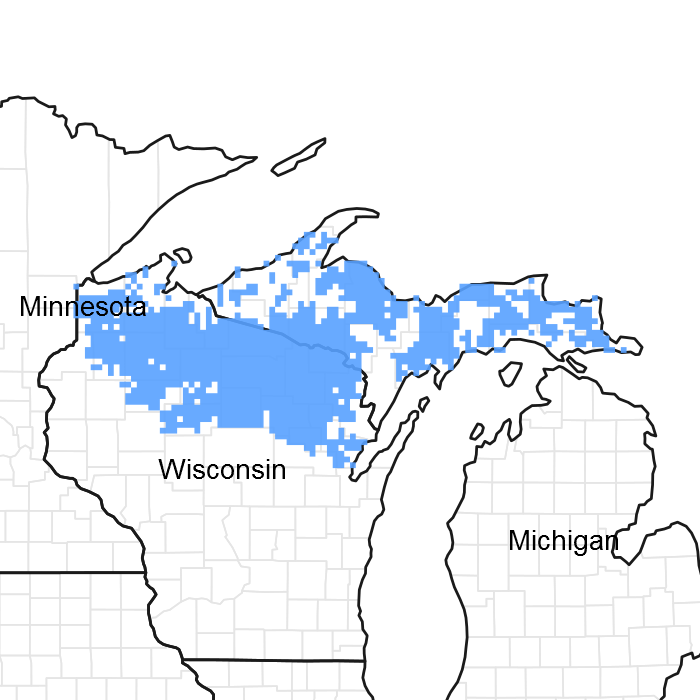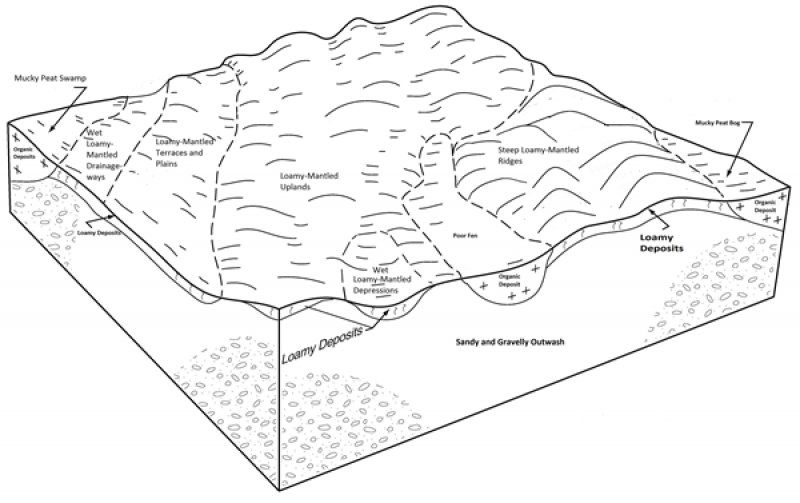Ecological dynamics
This ecological site supports a mesic northern hardwood and conifer forest with an understory of ferns, spring ephemeral wildflowers, sedges and grasses, and shrubs. The understory can be species rich or sparse depending successional stage. Later seral stages have a closed multi-layered canopy, with a high leaf area index. This condition restricts light penetration, which in turn, limits understory productivity. Early seral stage forests, mainly aspen and birch, allow more light to the forest floor and this results in a denser understory, often with a well developed shrub-sapling layer. Small-scale disturbances, such as windthrow, insect damage and plant diseases play a major role in creating a diverse and patchy plant community on this site. Windthrow is common on sites that have a lithologic discontinuity in the soil; which on this site is the loamy soil over sand and gravel. However, some sites are more exposed to wind than others, so location plays a major role as well. A site that is subject to high windthrow hazard typically displays a profound pit and mound micro-topography over most of the forest floor. This is especially true where the loamy mantles contains a high silt content. Silty material has a high natural angle of repose and produces very stable and long-lasting "cradle-knolls".
State 1
Reference State
An undisturbed Reference State is hard to find these days. The floristic representation of early-seral, mid-seral and climax phases are mostly assumed from remnant populations. The early and mid-seral phases were the result of disturbances; the long-term trend toward the climax phase was the most common trajectory in the past. Now many sites fail to reach a climax phase before disturbance sets them back. Nearly all of the Reference State sites were harvested during logging era and these sites were often converted to farmland because they had the most productive soils with the fewest restrictions (i.e. wetness, stoniness, or droughtiness). However agricultural was still problematic and thus abandoned, promulgating old-field succession to the forested condition.
Community 1.1
Early-Seral Phase
This phase consisted of mainly aspen and birch but conifers such as balsam fir and red pine were common associates. Small trees such as ironwood (Ostrya viginiana), black cherry and pin cherry (Prunus spp.) were are also common in the re-generating forest. Shrubs were abundant on sites that received sunlight; these included beaked hazel, maple-leaf viburnum and several dogwood species.
Community 1.2
Mid-Seral Phase
This phase consisted of mainly red oak and white pine with more shade tolerant trees such as sugar maple, yellow birch and basswood dominating the seedling and sapling layers. Shade tolerant conifers like hemlock and white spruce are appearing in the understory in specialized habitats, mainly the cooler, shadier sites.
Community 1.3
Climax Phase
The climax phase has a dense canopy of sugar maple and hemlock with very little understory vegetation. The understory is mainly ferns and small, spring-ephemeral wildflowers. This phase persisted for many centuries as the canopy were able to reproduce under the overstory. When gaps appeared through the death of individual trees, advance regeneration of the overstory species filled them. The sugar maple-hemlock cover type is largely credited with producing strongly podzolized soils. These soils are highly acidic, however they are typically nutrient rich and very productive.
State 2
Cutover State
The Cutover State has largely replaced the Reference State. These sites often have a mix of early- and late-successional species due to frequent natural disturbances and selective logging practices. Then again, mono-cultures of aspen or maple can develop in patches on these site due to same disturbance factors. The reality is that this site has many possible combinations of species, and those species must compete intensely for the available resources.
Community 2.1
Aspen-Birch Phase
This phase has become more common over time as man-made disturbance increases in forested areas and cleared land reverts to forest. Markets exist for aspen and birch pulpwood, so that increases that likelihood of even-aged management. Clear-cutting stands of aspen before they start to deteriorate is one the most economically sound forms of forest management. Not only does it provide a useful forest product, it also encourages aspen regeneration. It also benefits a number of popular wildlife species (namely whitetail deer, ruffed grouse, and golden-winged warblers) to have stands of different age class aspen on the landscape.
Community 2.2
Red Oak-White Pine Phase
This phase was a common replacement stand to the Aspen-Birch Phase because of the abundance of this phase as the edaphic climax phase on nearby sandy ecological sites. This phase is very popular with landowners and forest managers for its scenic value on one hand and timber value on the other. This value puts a premium on management for these species. While there is no particular shortage, there is high demand for this phase.
Community 2.3
Sugar Maple-Hemlock Phase
This phase is long-lived but in the modern forest it is subject to numerous disturbances. It is now relegated to areas protected from natural and man-made disturbances.
State 3
Invaded/Disturbed State
This very common state will over time closely resemble the Cutover State except for the addition of invasive species. However, in some extreme cases the post-logging condition of the site precludes timely forest regeneration. This may be due soil compaction, excessive rutting or introduction of particularly aggressive weeds. Soil compaction and rutting result from vehicle traffic when the soil too wet to bear the load. The loamy-mantled soils on these sites have a higher water-holding capacity and slower permeability than nearby sandy soils, so it may appear that vehicle traffic won't be problem when in fact it is. The Earthworm Phase is common in areas near lakes, roads, trails, farm fields, and dwellings. Weeds also follow these invasion routes.
Community 3.1
Earthworm Phase
This is probably now the most common phase on this ecological site. Non-native earthworms have successfully colonized all suitable habitat in this area in the last 150 years and Loamy-Mantled Uplands are the most favorable of sites. The plant community can be anything from closed canopy maple-basswood forest to agricultural crops. The effects of earthworm colonization include loss of organic surface layers, increased weeds, increased erosion potential and decreases in some native wildflowers such as twisted-stalk and bellflower. It must also be noted that some native wildflower species have increased due to earthworms; these include trilliums and jack-in-the-pulpit.
Community 3.2
Invasive Weeds Phase
Invasive weeds have encroached on many sites where the canopy has removed, especially along roads, trails, and near building sites. One of the most problematic species on this garlic mustard, which has dramatically spread in southern Wisconsin and is moving north. Fortunately, many of the common post-logging invasive weeds, such as sweet clover and mare's tail, are shaded out when the site is reforested.
Community 3.3
Recent Logging Phase
Logging introduces many changes to a site besides canopy removal. More sunlight reaches the forest floor, thus surface temperatures increase which in turn, and causes increased organic matter decomposition. Ground flora becomes taller and denser, and native pioneer species are favored. The negative aspects of these changes are the increases in non-native species and loss of habitat for desirable species. However, well planned logging operations can have little or no negative consequences, especially when they leave a site that resembles the aftermath of natural disturbances, mainly in the form of woody debris and non-compacted soils.
State 4
Converted State
The Converted State involves removal of existing vegetation (i.e. land clearing) and transforming the site into completely different land use. This can advantageous if the site was previously disturbed and is currently infested with problematic species. Otherwise this practice causes loss of native forest habitat. Ideally, redevelopment of disturbed sites will be encouraged and undisturbed sites will be left in forested sites.
Community 4.1
Pine Plantation Phase
Planting conifers was a widespread practice back in the days of cheap labor. Today, smaller commercial or private land plantations are more commonly created, rather than the large pine plantation on public land of earlier years. After 50 years or so of sound management, older pine plantations begin to resemble natural stands with multiple layers and a diverse understory.
Community 4.2
Developed Phase
The creation of this phase reached a high point years ago and has since cooled off. The developed sites are beginning to blend in to landscape in a visual sense but they are still sources of invasive species and plant diseases brought into the area.
Community 4.3
Agricultural Phase
The Agricultural Phase acreage peaked many years ago and is now a mere remnant of its former extent. Many old fields are succeeding to trees and shrubs. There is still some cropland but most agricultural land is now hayland or pasture.


